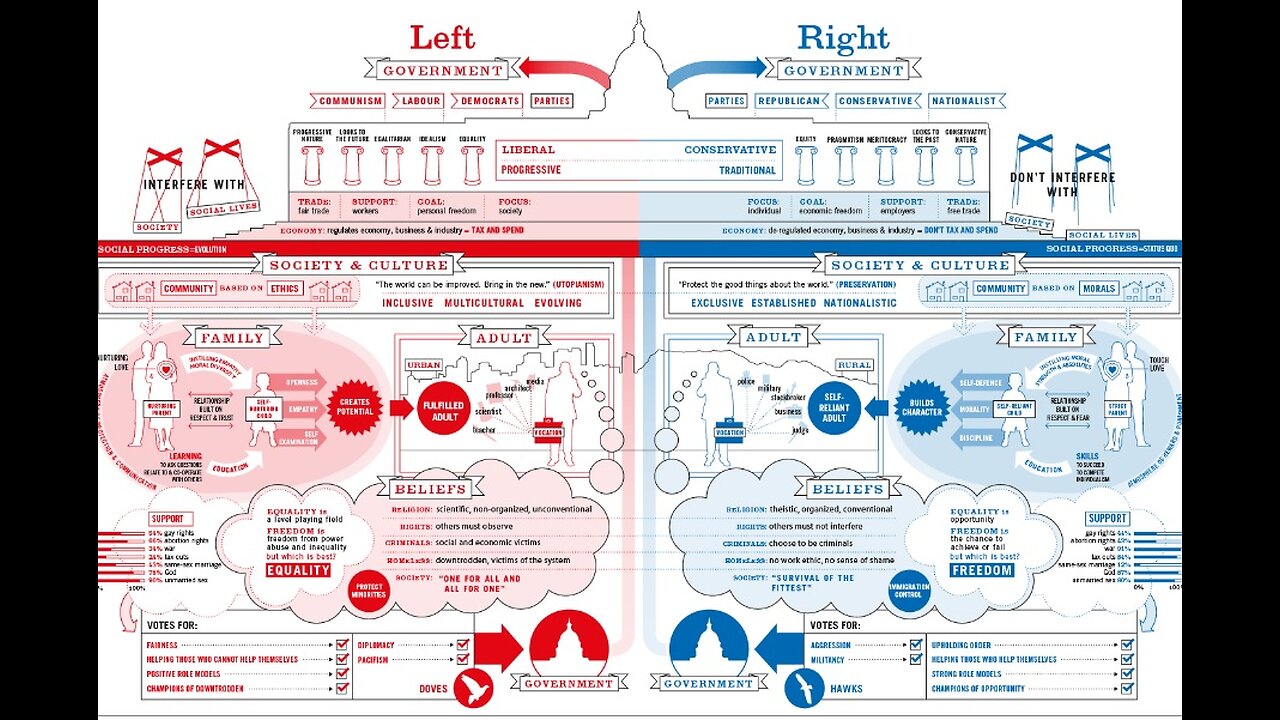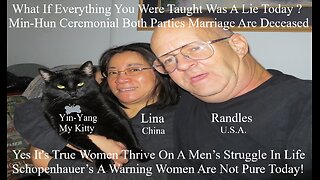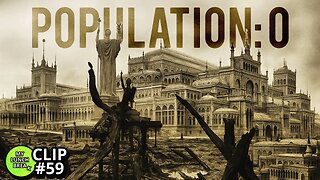Premium Only Content

Orwellian Dystopia Both Side's Are Wrong Answer To Extremism Isn’t More Extremism
America’s left and right are radicalizing each other, and the precedents from overseas are deeply unsettling. It’s all politics. And it still is, for those who really listen close. It’s why we need to flip the script and tell the real story of what happened in 1948 and 1964. I also believe America needs to echo, once again, Martin Luther King, Jr.’s dream and “look to a day when people will not be judged by the color of their skin, but by the content of their character.” That’s what made America great…and will make America great again. It’s known as “The Big Switch.” That’s when Southern Democrat politicians converted to Republicanism and refashioned the G.O.P. into a racist political party. Orwell's "1984" has been quoted left and right, for years, but the reality that we currently live in has never resembled the dystopia that the author describes in his best-known novel as much as it does today. We are voluntarily giving up our privacy. We are forced to use it as a currency. That has never been the case before, but today it is.
It is almost impossible to function in today's world without giving up your privacy or rather having it invaded by a corporation or a government. The internet has, clearly, played a huge part in this. It may have brought us closer, but it has also brought governments and corporations closer to us, practically invited them into our homes and minds. "Both rely on the existence of a technological system with the capacity to monitor every citizen’s actions and words.” Meanwhile, governments all over the world, including the United States, are installing more mass surveillance, further invading little what's left of their citizen's privacy. We have been conditioned to feel OK about giving up our privacy (after all, don't they want to "protect" us from terrorism?), but governments and corporations use this information in countless ways. For example, Google's and Facebook's sophisticated algorithms are capable of profiling you to such an extent, that serving highly targeted advertisements and propaganda is a fully automated process.
You can even test this yourself -- try looking for something specific to buy and see what type of ads Facebook serves you. Is there any way to combat this? Saying "I have nothing to hide" and allowing the government to spy on you is like claiming you have nothing to say and allowing the government to take away your right to freedom of speech.
The 30-something author documented how the Democratic Party–known for its historic racism–split in 1948 when Harry S. Truman (D-MO) first “introduced a pro-civil rights platform” into the Democratic Party. Strom Thurmond (D-SC) and a faction of Southern Democrats, consequently, bolted from Democrats to create the “States Rights” (Dixiecrat) party. The author then states these Dixiecrats eventually converted to Republicanism–along with Thurmond–in 1964. Later, Nixon’s “southern strategy” and Reagan’s conservatism moved the Democratic “blue” South to become a firm “red” Republican in the 1970s and 1980s.
Today, Democrats routinely finger Republicans as “racists,” pointing to occasional neo-Nazi politicians (David Duke, a one-term Louisiana state legislator), obscure racist organizations (Patriot Front) and Confederate flag-waving MAGA types. In fact, just wearing a MAGA hat is considered “racist” by many individuals on the left. It’s a strong and divisive narrative…but what’s the TRUTH?
First of all, the “Dixiecrats,” under Strom Thurmond in 1948), did leave the Democratic Party…but for reasons more than racial. The Truman Administration–following sixteen years of Franklin D. Roosevelt–further desired to federalize and centralize government. The Southern Thurmond “Dixiecrats” believed in traditional “states’ rights” and segregation. The Northern and Western Democratic Party in the 1930s and 1940s was more “progressive” politically. President Roosevelt’s fascination with the Italian dictator Benito Mussolini and fascist government programs in Europe guided many of his domestic policies.
Consequently, the 1948 Truman-Democratic platform reflected more centralized and socialist government, thus angering and distancing Southern libertarians. That’s what really split the Democratic Party in 1948. In fact, in a platform that boasted 4,256 words only 106 (2.4%) were even devoted to civil rights (for the black or anyone else). Even more surprisingly was how the party of slavery, segregation, Ku Klux Klan and Confederate secession was quick to pat itself on the back in 1948. In their summary on civil rights the Democratic Party actually claimed it alone was “responsible for the great civil rights gains” and committed to “continuing its efforts to eradicate all racial, religious and economic discrimination.”
However, such 1940s political posturing is contradicted by a Jim Crow Democratic South that still lynched blacks, refused school, hotel, restaurant, transportation and restroom facilities to “coloreds” and rigged voting procedures to suppress the black ballot. Therefore, it’s hard to believe “great gains” were actually made by Democrats. Harry Truman was allegedly an inactive participant in the Missouri KKK, and biographers often noted his latent racism against blacks, Jews, Chinese and Japanese throughout his life. Meanwhile Franklin D. Roosevelt nominated a KKK member to the Supreme Court (Hugo Black), put Japanese-Americans into detention camps and refused to welcome black Olympians—including the famed Jesse Owens—to the White House.
The Dixiecrat exodus was, again, more about progressive, fascist, socialism than segregation and black civil rights. In the end, despite predictions of a Thomas Dewey victory, the Dixiecrat exodus produced little gain. Truman won the ’48 presidency in a landslide electoral college vote while the Dixiecrat Strom Thurmond mustered an inconsequential 2.4% of the popular vote.
Secondly, the Dixiecrats did NOT convert to Republicanism in 1964 (after Lyndon B. Johnson signed the Civil Rights Act) as many historians and journalists now suggest. In fact, most of these racist libertarians returned to the Democratic Party after 1948 and became a significant voting block against civil rights and desegregation throughout the 1950s and early 1960s. According to one historical analysis, of the 1500+ racist “Dixiecrats” only Strom Thurmond and about a dozen others left the Democratic Party for the GOP (less than 1%). Furthermore, Thurmond didn’t switch parties until 16 years after Truman forced him to create his “Dixiecrat” party.
Thirdly, Southern whites (the people, not the politicians) did vote more REPUBLICAN in post-1965 elections, but not for racial reasons. Again, the Democratic Party was moving left, toward socialism, nonreligious/atheism and adopting liberal planks on abortion, women and gay rights. The Bible Belt South in the 1970s and 1980s became less racist as de-segregation and civil rights laws were enforced. Consequently, immigration to southern cities (Atlanta, Dallas, Houston, Nashville, Charlotte) by northern and western GOP conservatives rearranged the voting demographic. Southerners are more conservative and that’s why dozens of Democrats switched parties. Did you know notable Republicans Trent Lott, Mike Pence, William Bennett and Rick Perry were all previously Democrat? It’s true. And race was not the reason they switched affiliations…it was due to liberal/socialist policies.
Finally, the Republican Party and its leaders have consistently denounced and resisted the “alt right” ultra-conservative racist organizations. It’s why these racists formed their own political party in 2009 (The American Freedom Party). Republicans, historically, have always championed civil rights for the black and all ethnicities. The Civil Rights Act of 1964 passed thanks to widespread Republican support (who had proposed similar legislation in the Eisenhower administration). All Southern Democrats (including those Dixiecrats) voted against it. Oh, and David Duke? He only identified as Republican when politically expedient. Otherwise, he’s been in the Democrat, Populist or Reformed camp.
Maybe instead of looking at the anomaly of Strom Thurmond, we should investigate the political expediency of another Democrat: Robert C. Byrd (D-WV) who spent 62 years in public office. Byrd served for over half a century at the national level, as a Representative and, later, a powerful Senator. Byrd died in office (2010) at the ripe age of 92. Hillary Clinton called Byrd a “friend and mentor.” Barack Obama noted how “the arc of his life bent toward justice.” The press gave him a blessed pass.
That’s because Robert Byrd proved a quintessential post-WW2 Democrat. Originally a member and leader of the Ku Klux Klan in West Virginia (an affiliation he later disavowed), Byrd refused to fight in World War 2 because it meant serving alongside blacks. He routinely voted with other segregationists in the 1950s. As a senator, Byrd filibustered and voted against the 1964 Civil Rights Act. He abstained his vote for the 1965 Voting Act. He also voted against the confirmation of Thurgood Marshall, the first black Supreme Court justice.
This same Robert Byrd then politically transformed from a known racist to a beloved mentor. How? Simple. He towed the party line…for nearly 57 years! It’s possible to argue Byrd didn’t lose his racism but rather, like most good politicians, shelved it. He enjoyed his power and position. It wasn’t the first time Byrd did what was necessary. In fact, the whole reason Byrd initially joined the KKK was for “political power.” To his credit, he did leave the organization, but still it showed Byrd to be a political opportunist. Once in national office, at least until 1967 (when being a segregationist went out of fashion), he retained his racist roots. Byrd told a reporter: “Don’t get that albatross [the KKK] around your neck. Once you’ve made that mistake, you inhibit your operations in the political arena.”
There is a website that I frequent because it puts up a lot of interesting information in fun graphs, infographics and pictures. Information is Beautiful posts a wide range of topics from China’s censorship to illegal drugs. The following image is from their “Left vs Right (World)” post, outlining the basic gist of the left-wing and right-wing political ideologies. There is only so much that you can include in a diagram trying to distinguish the political left from right. This is a generic point to start understanding the main differences between the two sides but we need to keep in mind that there are many degrees of variation on political views (even within the same one). This diagram makes the right-wing way of thinking to be completely cold, calculated and rational, while the left-wing ideas promote more positive views on humanity. While it is true that the right-wing tends to support war, morals and discipline, it should be understood that left-wing can have corruption, discipline and rules.
And what about the people that do not fall strictly into one wing or another? When I was younger and just beginning to learn about political terms and ideas, I was massively confused. What the media taught me was that (I watched a lot of US politics on TV) you are either left or right. There I stood, utterly confused at how I could possibly believe in personal and economic freedom supported by a minimal government role in each aspect. For example, on this graph, I agree with the leftist thought of being progressive and supporting personal freedom. However, I also believe in the right wing ideals of non-interference in society, low taxes, and economic freedom. Yet, I do not believe in organized religion and I fully support gay and abortion rights.
What this diagram shows is that many of us are still stuck in a dichotomous way of thinking, when there are eons of possibilities for a political perspective. Left and right are the most basic division in politics but that should not encourage or pressure people to conform to simply one side or another.
I love Information and is infographics hold a special place in my heart for their ability to effectively convey information in appealing and efficient ways.
In response to the point you make, I agree that we seem to have been protected from the possible existence of ambivalence in political views as if it were some sort of secret. It feels a little strange to say that it is for the public’s best interest, but that’s sort of what I’m arguing.
The left – right divide may not so much serve as dichotomous camps that we must choose between, rather they serve as a simplified roadmap to guide the less politically aware public. What will determine where you place yourself will depend on how much weight you give to specific topics. It’s generally accepted that the citizenship will not know about where they stand on each individual issue, so by using this shortcut they can hopefully make an educated guess that will eventually serve them well.
-
 27:25
27:25
What If Everything You Were Taught Was A Lie?
9 days agoYes Women Thrive On A Men’s Struggle In Life Schopenhauer’s Warning Women Are Not Pure Today
2.18K4 -
 LIVE
LIVE
GloryJean
1 hour agoAggressive Solo Gameplay on Mouse & Keyboard 🖱️ 6.7 K/D
42 watching -
 LIVE
LIVE
The Pascal Show
43 minutes agoBREAKING! Mass Shooting At Annunciation Church In Minneapolis Multiple Shot
88 watching -
 1:43:04
1:43:04
Dear America
3 hours agoNo More IRS!! Tariffs Bring In Over $500 BILLION! + Taylor Swift Got ENGAGED… This Is A Nightmare!!
75.2K67 -
 LIVE
LIVE
Caleb Hammer
18 hours agoHe Just Sucks… | Financial Audit
61 watching -
 LIVE
LIVE
MYLUNCHBREAK CHANNEL PAGE
1 hour agoThe Population Was ZERO
425 watching -
 LIVE
LIVE
Wendy Bell Radio
6 hours agoTrump Cracks The Barrel
7,406 watching -
 LIVE
LIVE
The Big Mig™
2 hours ago2020 Election Fraud Burn Bags Discovered
5,125 watching -
 LIVE
LIVE
Law&Crime
2 hours agoLIVE: Adelson Matriarch Murder Trial — FL v. Donna Adelson — Day 4
112 watching -
 LIVE
LIVE
Badlands Media
10 hours agoBadlands Daily: August 27, 2025
3,683 watching